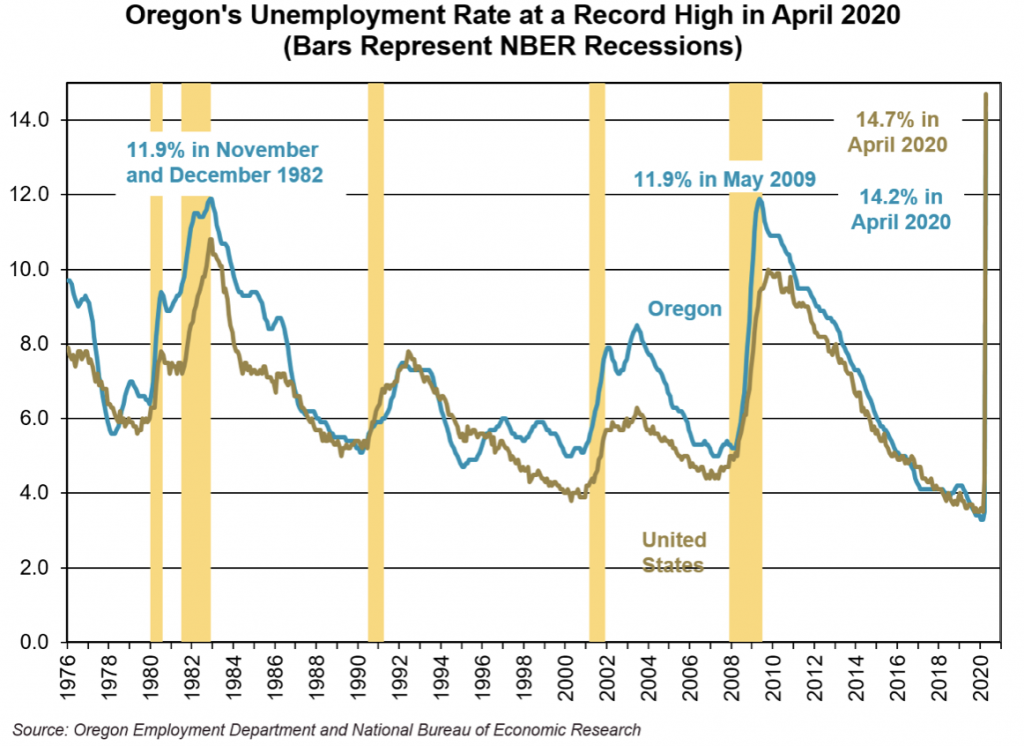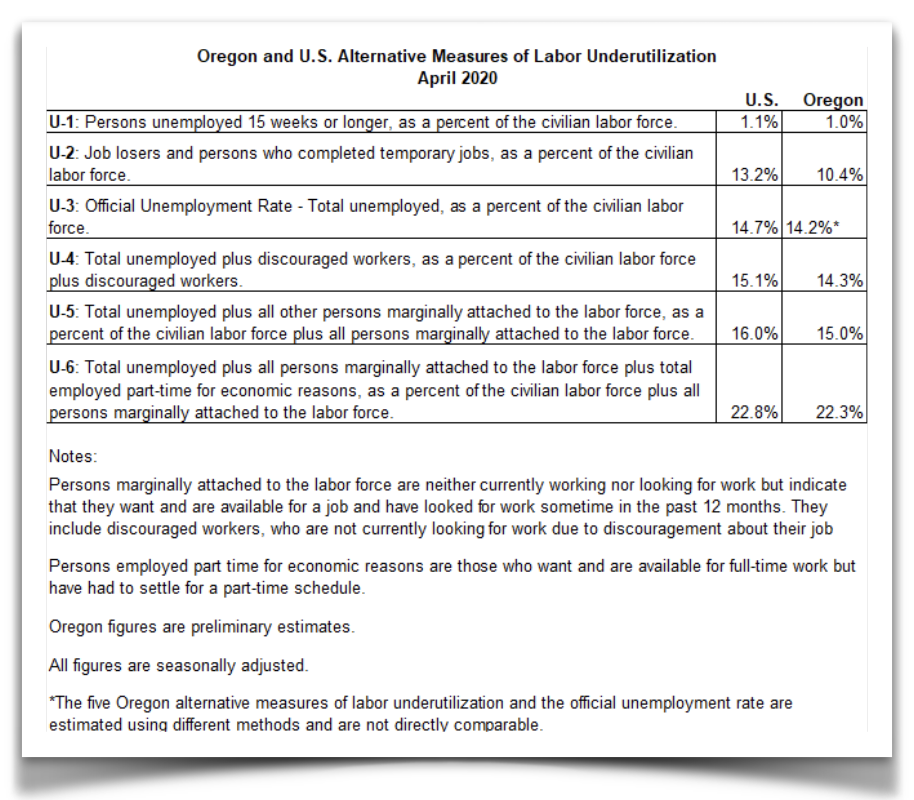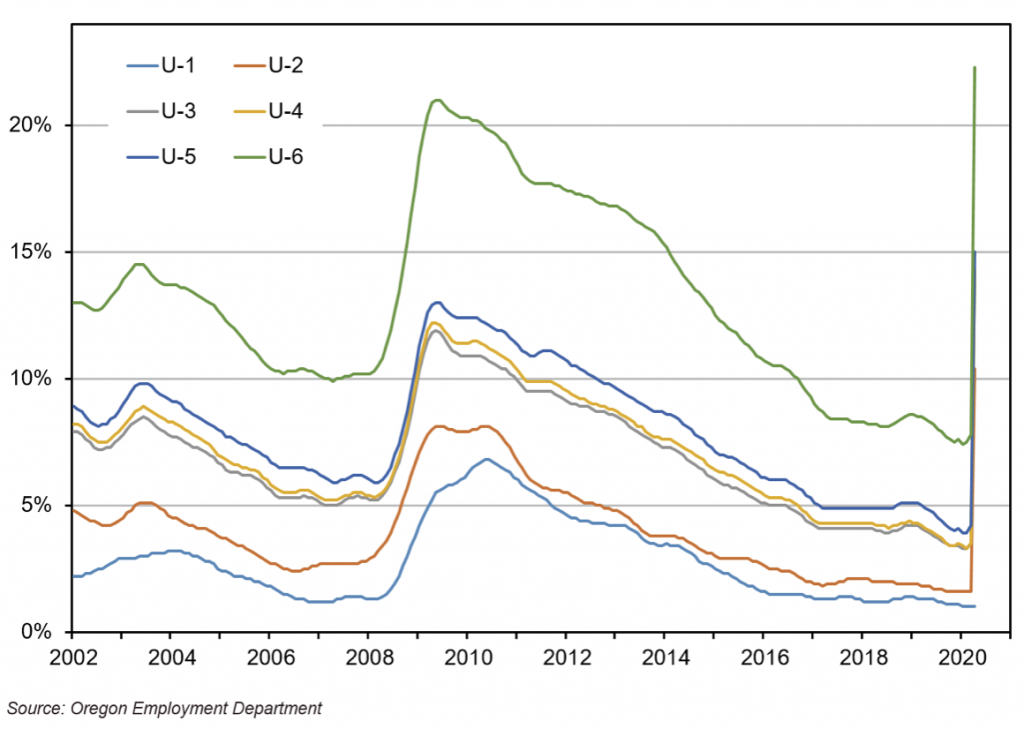Labor Underutilization and the Effects of COVID-19
by Anna Johnson, Senior Economic Analyst, for Employment in Oregon

Public health measures related to COVID-19 began in Oregon in mid-March. Social distancing practices and workplace and gathering changes have severely impacted business practices all around the state. Employment data for the month of April gave a startling look the impact the pandemic has had on Oregon’s economy. In April 2020, Oregon’s unemployment rate was 14.2 percent, a record high with comparable data going back to 1976. Before, the highest unemployment rate Oregon had seen was 11.9 percent in November and December 1982 and May 2009. This high unemployment rate and record month-to-month jump do not capture all of the economic distress Oregonians are experiencing. To understand more fully, we can look at other measures of labor underutilization.

The official definition of unemployment used by Bureau of Labor Statistics is all persons within the civilian noninstitutional population (CNP) who do not have a job, but are currently available for work and are actively searching for work. The CNP consists of all persons age 16 years and over, excluding those on active duty in the U.S. Armed Forces and the institutional population (e.g., prison inmates or those in homes for the aged). Unemployment is sometimes thought to include only those individuals who both qualify for and are receiving unemployment insurance benefits. However, many outside this group are considered to be unemployed based on the official definition used by BLS. Examples include those who have exhausted unemployment benefits, new labor market entrants – including recent high school and college graduates – and those who are not covered by unemployment insurance, such as the formerly self-employed. These groups are considered unemployed as long as they are actively seeking work.
The official definition of unemployment also excludes certain groups who are sometimes thought of as being unemployed or “underemployed.” Those who would like to work and have actively searched for work sometime in the last 12 months – so-called marginally attached and discouraged workers – are not counted in the official definition because they are not currently seeking work. People working part time who would prefer full-time work are also not counted as unemployed because they are working – albeit fewer hours than they would like. Finally, those who are not employed (i.e., did work for pay or profit) and do not fit the above definition of unemployed are classified as “not in the labor force.”

In recent years the “Alternative Measures of Labor Underutilization” published by the U.S. Bureau of Labor Statistics have grown in popularity as statistics for identifying slack in the labor market. These alternative measures, commonly identified by a “U” in front of a number from 1 to 6, provide both more narrowly (U-1 and U-2) and more broadly (U-4, U-5, and U-6) defined estimates of labor underutilization than the official unemployment rate (identified as U-3). The various measures range from very narrow to very broad definitions of “underutilization,” relative to the official definition of unemployment.
The narrowest measure, U-1, tracks the number of persons unemployed 15 weeks or longer as a percent of the civilian labor force. By this measure, 1.0 percent of the Oregon labor force met this criterion in April 2020. In Oregon, U-1 was within a range of 1.3 and 1.9 percent from 2006 through 2008, before peaking at 6.7 percent in 2010. Currently, this measure is now at a level comparable with the values immediately prior to the Great Recession. Because this measure tracks those unemployed 15 weeks or longer, we would not expect to see an immediate spike this early into the pandemic. It remains to be seen what will happen with this measure as counties begin the process of opening up businesses and social distancing protocols are loosened.
The second measure, U-2, considers the percentage of job losers and persons who completed temporary jobs as a percentage of the civilian labor force. In April 2020, 10.4 percent of the Oregon labor force met this definition. In the prior month, the U-2 was only 1.6 percent, a record low. During the Great Recession and its aftermath, the U-2 reached a high of 8.0 percent.
The broader measures begin by adding discouraged workers to the unemployed. Discouraged workers are defined as those who want a job, are available for work and have searched for work in the prior year; however they are not currently looking for a job for reasons related to the job-market. If these workers are added, the measure results in only a modest increase relative to the official rate. In April 2020, the U-4 was 14.3 percent, up from a near record low of 3.5 percent in March 2020. Around the time of the Great Recession, this measure reached a high of 12.2 percent.
Measure U-5 includes not only discouraged workers but all “marginally attached workers.” Marginally attached workers are defined as persons who are neither working nor currently looking for work but indicate that they want and are available for a job and have looked for a job sometime in the past year. This group includes those who are not currently looking for work for reasons such as lack of child care or transportation. Using this definition, 15.0 percent of the Oregon labor force plus marginally attached workers meets these criteria in April 2020. This measure was at a record low in February and January of 2020, 3.9 percent, and at only 4.2 percent in March. During the Great Recession, this measure reached a high of 13.0 percent in May and June of 2009.
Finally, the broadest measure of labor underutilization, U-6, includes not only all unemployed and marginally attached persons, but also those employed part time for economic reasons. This latter group provides an objective measure of a portion of the underemployed (the so-called “involuntary part-time workers”). The BLS defines “part-time workers” as those who worked less than 35 hours during the reference week of the Current Population Survey. To be classified as employed part time for economic reasons, an individual must also be working part time because of poor business conditions or because of the inability to find full-time work and must want and be available for full-time work. Involuntary part-time employment does not capture all underemployed, such as those whose education may qualify them for a more highly skilled position. However, these types of underemployment are fairly subjective and more difficult to quantify. Using the broadest measure of labor underutilization tracked by the BLS, U-6, 22.3 percent of the civilian labor force plus the marginally attached was either unemployed, marginally attached to the labor force, or underemployed in April 2020. Oregon’s U-6 was at a record low of 7.4 percent in January 2020 and reached a previous high of 20.1 percent in April 2010.
All measures respond in a similar fashion to the business cycle. Regardless of which measure is deemed appropriate, rates of labor underutilization have generally moved up and down together. While the rates for measure U-6 are high relative to the official definition of the unemployment rate (U-3), both U-3 and U-6 show very similar economic trends in Oregon’s labor market over time. All measures, except for the U-1, spiked to record highs in April 2020. It will be important to track these measures to see how Oregonians are being impacted by COVID-19.


Advertisement